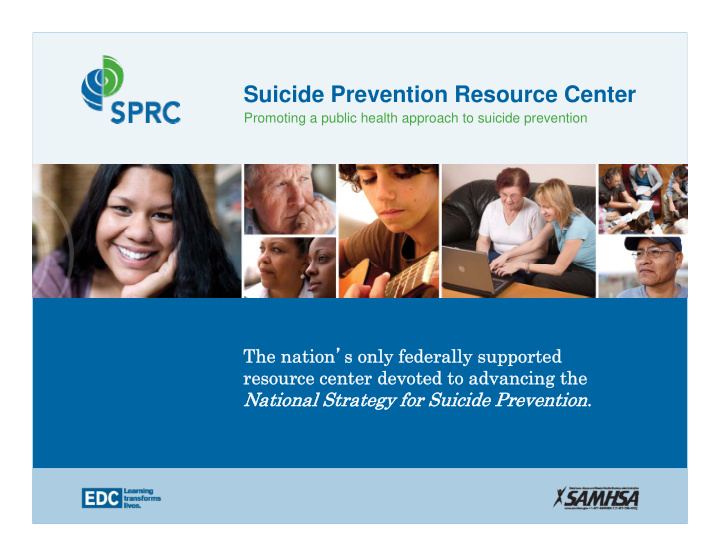



Suicide Prevention Resource Center Promoting a public health approach to suicide prevention The nation The nation ’ s only federally supported s only federally supported resource center devoted to advancing the resource center devoted to advancing the National Strategy for Suicide Prevention National Strategy for Suicide Prevention .
System-level data and System-level data and surveillance in juvenile surveillance in juvenile justice and foster care justice and foster care 2016 GLS Grantee Meeting May 3, 2016 Teri Covington, MPH , National Center for the Review & Prevention of Child Deaths Ellyson Stout, MS , Suicide Prevention Resource Center
Our Session T Our Session Today day Brief overview of suicide risk for systems-involved youth Suicide surveillance in Juvenile Justice and Child Welfare systems Child Death Review systems Group discussion
Systems Involved Systems Involved Youth uth Juvenile Justice: >31 million youth under juvenile court jurisdiction 79% ages 10-15 Minority youth overrepresented (esp. African Americans and AI/AN) Child Welfare/Foster Care ~415,000 children in foster care 46% in nonrelative foster family homes 6% in group homes 29% in relative foster family homes 5% on trial home visits 8% in institutions 4% in preadoptive homes National Center for Juvenile Justice, Office of Juvenile Justice and Delinquency Prevention. Juvenile Court Statistics 2013 . Accessed online at: http://www.ojjdp.gov/ojstatbb/njcda/pdf/jcs2013.pdf Children’s Bureau, Administration for Children and Families. Foster Care Statistics 2014 . Accessed online at: https://www.childwelfare.gov/pubs/factsheets/foster/
Systems-involved AI/AN Systems-involved AI/AN youth youth AI/AN Youth in Juvenile Justice: – Disproportionate % of juveniles in custody – Higher rates of out-of-home placement or waiver to adult system – Multiple jurisdictions/ double jeopardy AI/AN Youth in Foster Care: – Disproportionate reporting/system involvement – 10,000 AI/AN children – Majority under non-tribal care National Indian Child Welfare Association. Time for Reform: A Matter of Justice for AI/AN Children . Accessed online at: http://www.pewtrusts.org/~/media/legacy/uploadedfiles/wwwpewtrustsorg/reports/foster_care_reform/nicwareportpdf.pdf Coalition for Juvenile Justice. American Indian Youth and the Juvenile Court System . Accessed online at: http://tloa.ncai.org/documentlibrary/2010/09/factsheet_3.pdf/ Campaign for Youth Justice. A Tangled Web of Justice: American Indian and Alaska Native Youth in Federal, State, and Tribal Justice Systems. Accessed online at: http://www.campaignforyouthjustice.org/images/policybriefs/race/CFYJPB_TangledJustice.pdf
Suicide Risk in Juvenile Justice Suicide Risk in Juvenile Justice Youth in juvenile detention have high rates of trauma and mental health issues Elevated risk of suicide attempts and deaths Many show signs before detention Separation from loved ones, crowding, solitary confinement may increase risk Office of Juvenile Justice and Delinquency Prevention. Suicidal Thoughts and Behaviors Among Detained Youth . Accessed online at: https://educationdevelopmentcenter.sharepoint.com/teams/hhd/IVSPSS/sprc/ATARI/5- Populations%20and%20Settings/Juvenile%20Justice/OJJDP%20Suicidality%20in%20Detained%20Youth%202014.pdf
Suicide Risk in Child W Suicide Risk in Child Welfare lfare Youth in foster care more likely to have a mental health or substance use disorder High rates of physical/sexual abuse and neglect Youth in foster care experience Separation from parents and caregivers Frequent moves Sense of loss and shame Suicide Prevention Resource Center. Foster Care Providers: Helping Youth At Risk for Suicide . Accessed online at: http://www.sprc.org/sites/sprc.org/files/Fostercare.pdf
SPRC Project SPRC Project Assess needs and gaps around suicide surveillance in: Juvenile Justice Systems Foster Care Systems Public behavioral health systems Focus on suicide attempt and death data
Major T Major Tasks sks 1. Conduct Key Informant Interviews with top Administrators and National Agency Representatives from JJ and CW. 2. Identify “Success Stories” from GLS grantees who have successfully linked with JJ and CW. 3. Survey State GLS grantees to assess access to CW and JJ data and TA interest/needs.
Findings Findings Child Death Review teams play an active role in gathering information on in-system suicide deaths. Prioritization is a major barrier to collecting suicide- related information in a systematic way in JJ and CW systems. Suicide-related information in JJ and CW systems is currently used mainly for case management purposes and, less commonly, for system-improvement purposes.
Findings: Methodological Problems Findings: Methodological Problems JJ and CW data can have a host of methodological problems, including: Inconsistent reporting (stemming, in part from lack of consistent definitions in some systems) Use of narrative-based systems. Qualitative analysis of incident report data would be required to access this information. This is particularly common in CW. Small n’s (particularly for in-facility juvenile justice populations) Poorly-coordinated systems (e.g., Corrections, County Jails, and Diversion systems with different collection systems)
Findings: System Needs Findings: System Needs Given these barriers, JJ and CW systems need: Strong partnerships and reduced “silos” Help determining enhancements that could/should be made to the current system Resource assistance on common terms and definitions used nationally TA that is politically sensitive, designed to meet the needs of partners where they are
Findings: Other Supports Findings: Other Supports Those seeking to connect with JJ or CW should: Conduct a social network analysis to find previously-existing connections. Seek opportunities to “feed back” the data to JJ or CW. See what the system has to offer – you may need to think about using different data. Capitalize on public support when possible. Identify key stakeholders and establish buy-in early.
Resources Resources JUVENILE JUSTICE Action Alliance Juvenile Justice Task Force Resources: https://go.edc.org/ActionAllianceJJ National Center for the Review & Prevention of Child Deaths website: https://www.childdeathreview.org/ Screening and Assessing Mental Health and Substance Use Disorders among Youth in the Juvenile Justice System (OJJDP): https://www.ncjrs.gov/pdffiles1/ojjdp/204956.pdf Suicide Prevention in Juvenile Correctional Facilities webinar series: https://go.edc.org/SPRCJJTraining Suicidal Thoughts & Behaviors Among Detained Youth (OJJDP): http://www.ojjdp.gov/pubs/243891.pdf FOSTER CARE Youth Suicide Prevention Toolkit for Tribal Child Welfare Providers (NICWA): http://www.nicwa.org/YouthSuicidePreventionToolkit/YSPToolkit.pdf Foster Care Providers: Helping Youth at risk for Suicide: https://go.edc.org/SPRCFosterParents Preventing Suicidal Behavior among Youth in Foster Care (AAS): https://go.edc.org/AAS-Foster- Care
Questions & Questions & Discussion Discussion
Contact Us Contact Us Teri Covington Kristen Quinlan Elly Stout, MS tcovingt@mphi.org kquinlan@edc.org estout@edc.org 401-440-4062 617-618-2206 800-656-2434 Visit the SPRC website!: www.sprc.org EDC Headquarters 43 Foundry Avenue Waltham, MA 02453 www.edc.org
Recommend
More recommend